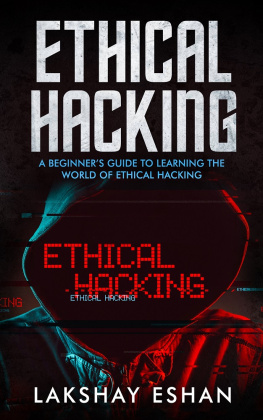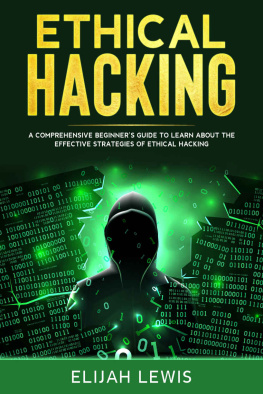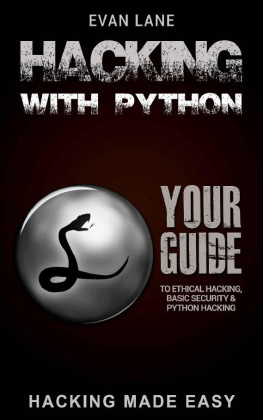Hacking for Beginners
Step By Step Guide to Cracking Codes Discipline, Penetration Testing, and Computer Virus. Learning Basic Security Tools On How To Ethical Hack And Grow
Karnel Erickson
Download the Audio Book Version of This Book for FREE
If you love listening to audio books on-the-go, I have great news for you. You can download the audio book version of this book for FREE just by signing up for a FREE 30-day audible trial! See below for more details!
Audible Trial Benefits
As an audible customer, you will receive the below benefits with your 30-day free trial:
- FREE audible book copy of this book
- After the trial, you will get 1 credit each month to use on any audiobook
- Your credits automatically roll over to the next month if you dont use them
- Choose from Audibles 200,000 + titles
- Listen anywhere with the Audible app across multiple devices
- Make easy, no-hassle exchanges of any audiobook you dont love
- Keep your audiobooks forever, even if you cancel your membership
- And much more
Click the links below to get started!
For Audible US
https://www.audible.com/pd/B081ZFW4RP/?source_code=AUDFPWS0223189MWT-BK-ACX0-173769&ref=acx_bty_BK_ACX0_173769_rh_us
For Audible UK
https://www.audible.co.uk/pd/B081ZHSSD3/?source_code=AUKFrDlWS02231890H6-BK-ACX0-173769&ref=acx_bty_BK_ACX0_173769_rh_uk
For Audible FR
https://www.audible.fr/pd/B081ZCF4KZ/?source_code=FRAORWS022318903B-BK-ACX0-173769&ref=acx_bty_BK_ACX0_173769_rh_fr
For Audible DE
https://www.audible.de/pd/B081ZGBFT8/?source_code=EKAORWS0223189009-BK-ACX0-173769&ref=acx_bty_BK_ACX0_173769_rh_de
Copyright 2019 - All rights reserved.
The content contained within this book may not be reproduced, duplicated or transmitted without direct written permission from the author or the publisher.
Under no circumstances will any blame or legal responsibility be held against the publisher, or author, for any damages, reparation, or monetary loss due to the information contained within this book. Either directly or indirectly.
Legal Notice:
This book is copyright protected. This book is only for personal use. You cannot amend, distribute, sell, use, quote or paraphrase any part, or the content within this book, without the consent of the author or publisher.
Disclaimer Notice:
Please note the information contained within this document is for educational and entertainment purposes only. All effort has been executed to present accurate, up to date, and reliable, complete information. No warranties of any kind are declared or implied. Readers acknowledge that the author is not engaging in the rendering of legal, financial, medical or professional advice. The content within this book has been derived from various sources. Please consult a licensed professional before attempting any techniques outlined in this book.
By reading this document, the reader agrees that under no circumstances is the author responsible for any losses, direct or indirect, which are incurred as a result of the use of information contained within this document, including, but not limited to, errors, omissions, or inaccuracies.
Introduction
Congratulations on purchasing Hacking For Beginners and thank you for doing so.
There are plenty of books on this subject on the market, thanks again for choosing this one! Every effort was made to ensure it is full of as much useful information as possible. Please enjoy!
How Are Victims Found? Fingerprinting, Google Hacking, and Co.
In front of a hacker attack on a system, it is common practice for an attacker to engage in education and to inform himself about the target system, if it is already known. This allows the attack to be tailored to the target and aligned with any weak points that may be present in order to be effective at all costs. Depending on the target and motivation of the attackers, various types of systems are attacked. The spectrum of these target systems ranges from unsuspecting surfers across web pages and servers to corporations and governments. The enlightenment phase - the phase before the actual attack in which a system is scouted out - can be subdivided into passive recognition and active enlightenment. By passive elucidation, we mean the gathering of information without direct contact with the target system. On the other hand, active enlightenment attempts to gather information through direct interaction with the target system. In passive enlightenment, foot-printing, attackers seek information about the entire target system. So it is trying to create a rough "footprint." The information you are looking for, for example, the hardware used, IP address ranges, IP addresses of individual computers or information about a company's employees. Active enlightenment or fingerprinting attempts to profile individual components of a system. Thus, individual computers are scouted to find vulnerabilities such as open ports. The attackers thus create a "fingerprint " of individual system components and thus try to discover potential entry gates.
The aim of this book is to introduce the techniques used in preparation for the preparations and to point out appropriate countermeasures. For this purpose, first, the various types of attackers and their motivation for attack and potential target selection are introduced. Subsequently, the phase of clarification with the techniques used in passive and active elucidation is presented in detail. Finally, countermeasures are shown, addressing both general measures and those specifically tailored to the clarification techniques presented here.
Chapter 1 Types of Attackers
As attackers differ in their motivation and technical capabilities, different types of attackers attack different types of systems and have different attacking intentions. According to Roge, attackers can be divided into seven types. These will be briefly presented below.
Newbie
Members of this group are mostly new to hacking and have only basic computer and network security skills. Therefore, they use preprogrammed software tool kits for their attacks. These software tool kits are widely used on the internet and easy to find. Their attacks are therefore limited to systems for which already existing tool kits exist.
Cyber Punks
Cyberpunks possess advanced software, programming, and system knowledge. They are quite criminal in their intentions. Cyberpunks attack web servers to redesign web pages (defacing) and are often active in spam and credit card fraud.
Internals
The Internals group consists of former and dissatisfied employees. They are usually technically savvy and can make attacks based on their former or current job functions and responsibilities. Their attacks are directed against their former or current employers since they can use their knowledge of the systems there.
Coders
This group has the extensive technical knowledge and is able to exploit security vulnerabilities and so-called program exploits.
Old Guard Hackers
This group does not necessarily pursue criminal intentions but is guided by the hacker ethic of the first hacker generation. According to [Raym03], hacking ethics is defined as the belief that information should be freely available, and the belief that attacks on computer systems are ethical. It is, therefore, considered ethical as long as no criminal intentions are being pursued, but rather the onslaught of fun and exploration enjoyment. Legally, attacks on computer systems are ethically unjustifiable and thus punishable.










